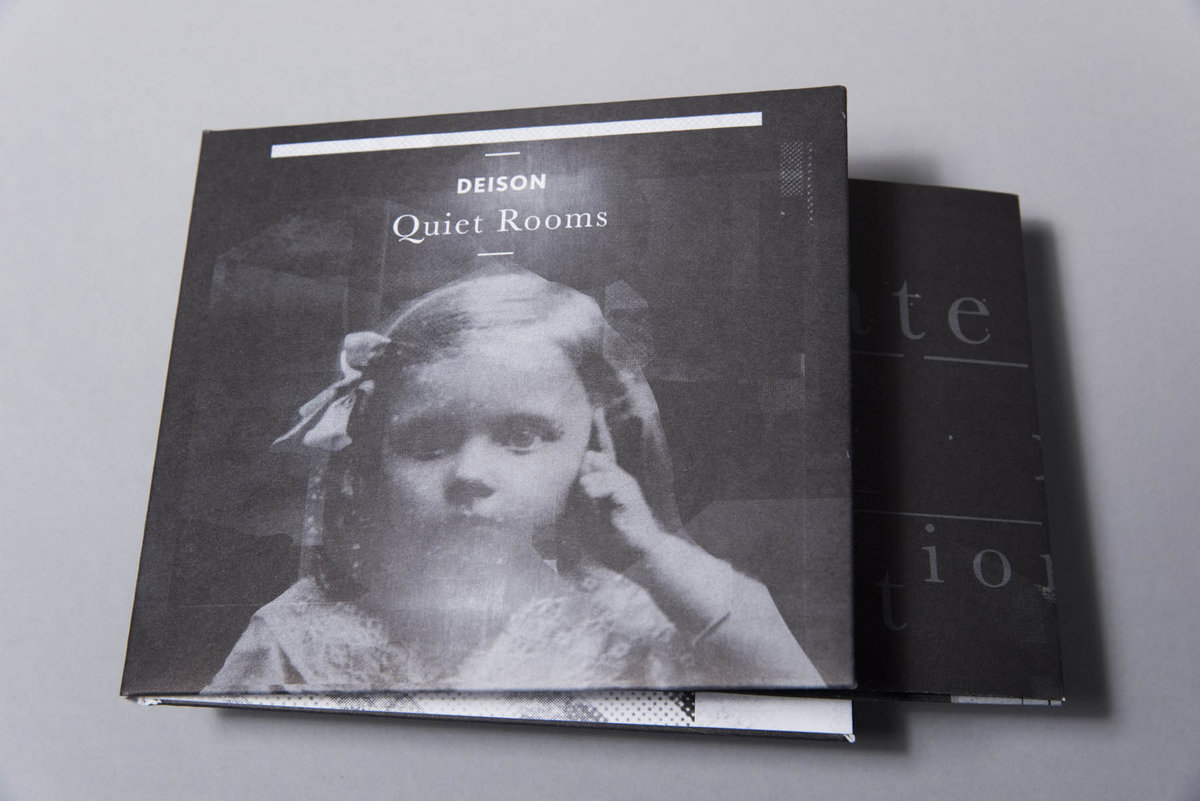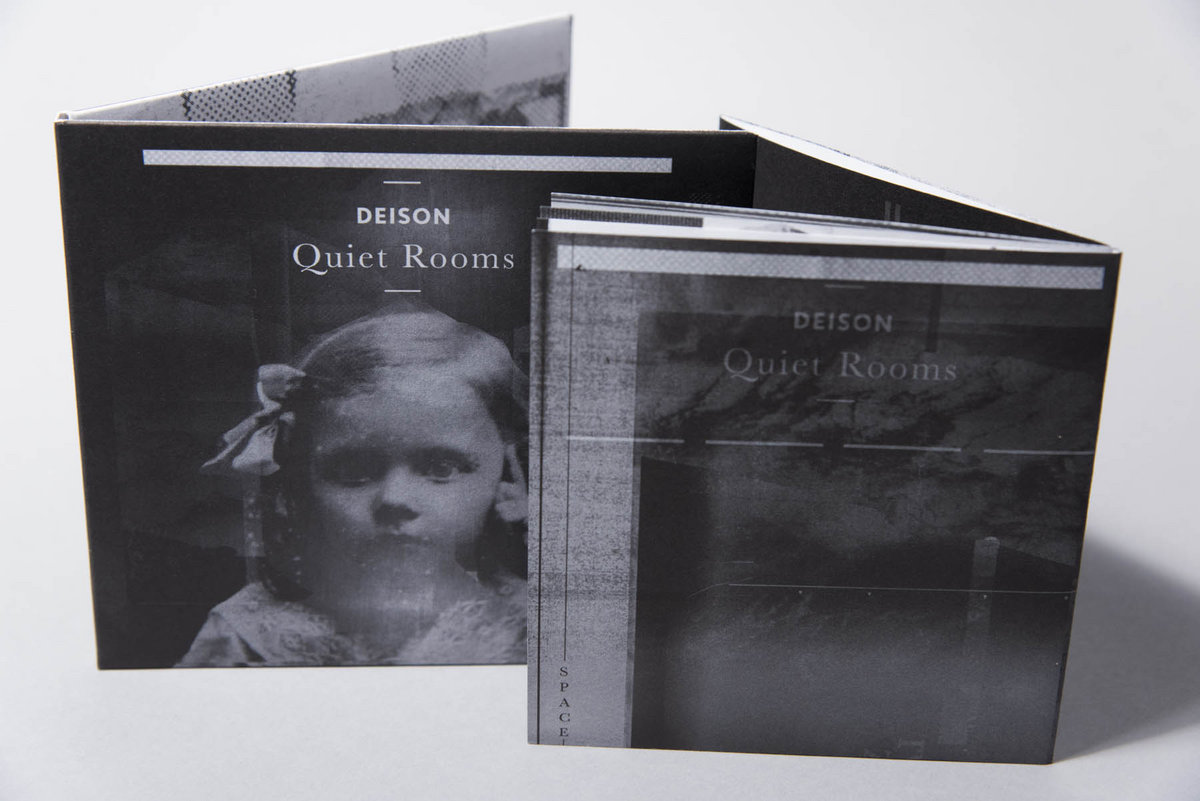DEISON
(CD, Agoo, 2012)

- Room I (Private Exploration)
- Room II (Lost Key)
- Room III (Not Available)
- Room IV (Air Conditioning)
On ‘Quiet Rooms’, the experimental artist builds four enchanting ambient soundscapes from field recordings of empty hotel rooms. Delicately layered and processed, these lonely urban soundtracks evoke powerful tensions between serenity and alienation.
In the he ethereal opener, “Room 1” Deison has captured the anxiety of isolation. Drones builds to such dystopian density that the sounds of our world become science fiction.
In “Room 3”, with the inclusion of distinguishable ambient hotel noises, Deison listens in on forgotten stories trapped in the walls. Doors open and close, phonecalls fail to reach their recipient, a distant cat meows. These are the intimate moments and mysterious lives of hotel guests.
Further adding to the tension of this powerful release is the 16 panel poster designed by Bas Mantel. Lock yourself into these stationary images and slow moving sounds. Spend time in Deison’s ‘Quiet Rooms’ and you will never look at an empty hotel room the same again.
Deison: electronics, synthesizer, Tape, field recordings
Sounds were recorded on various locations in hotel rooms in Barcelona, Venice, New York, Los Angeles and Milan.
Processed and edited at #1st Floor Studio, Italy.
QUIET ROOMS REVIEWED BY JULIAN COPE
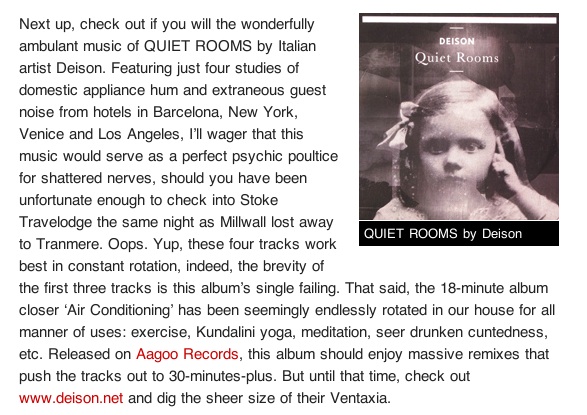
QUITE ROOMS SU KATHODIK
Cupa arte meditativa.
“Quiet Rooms”, è un vagabondare inquieto, sul limitar di un risuonante silenzio.
In bianco e nero lynchiano, livido e sfibrato.
Registrazioni di campo, tratte dalla macroamplificazione di vuote camere d’albergo, intrecciate e stratificate.
Microeventi che si accendono improvvisi.
Ronzanti drones, carichi di statica energia.
Il vuoto e l’immobilità dello spazio circoscritto, a diventar cinema per l’orecchio.
Furori, estranei e alieni, ad agitarsi percettibili, al di fuori delle finestre serrate.
Ambient, gassosa ed impalpabile.
Sinistramente rischiarata, da una luminescenza interna, che suggerisce un costante stato, di vigile allerta.
Filamenti di synth, tape, field recordings ed elettronica.
Pacificante ma non carezzevole.
Dove l’industrial ed il noise, son diapo ingrandite, fino allo sgranamento/collasso.
Resta una parete bianca da fissare.
Attimo dopo attimo.
Mentre ogni terminazione nervosa, intona un canto sommesso.
Son oltre vent’anni, che Deison aziona leve neurali (Meathead, Thurston Moore, Scanner, KK Null, Lasse Marhaug, Shee Retina Stimulants, la label Final Muzik. Azioni di pratica e condivisione).
Sempre in tesa, costante, panoramica experimental.
Dal minimale/impercettibile, al colpo in pieno petto.
“Quiet Rooms”, è pulviscolosa, chiaroscurale stasi.
Materica e notturna.
QUITE ROOMS SU BLOW UP
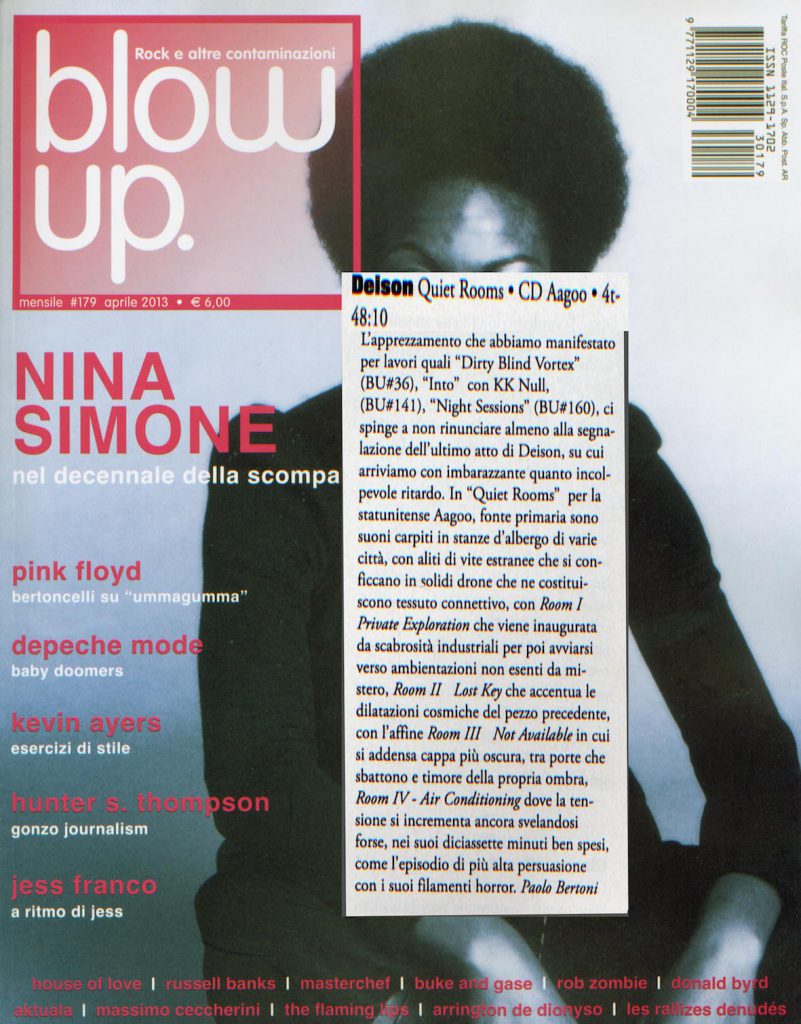
QUITE ROOMS SU ASCENSION
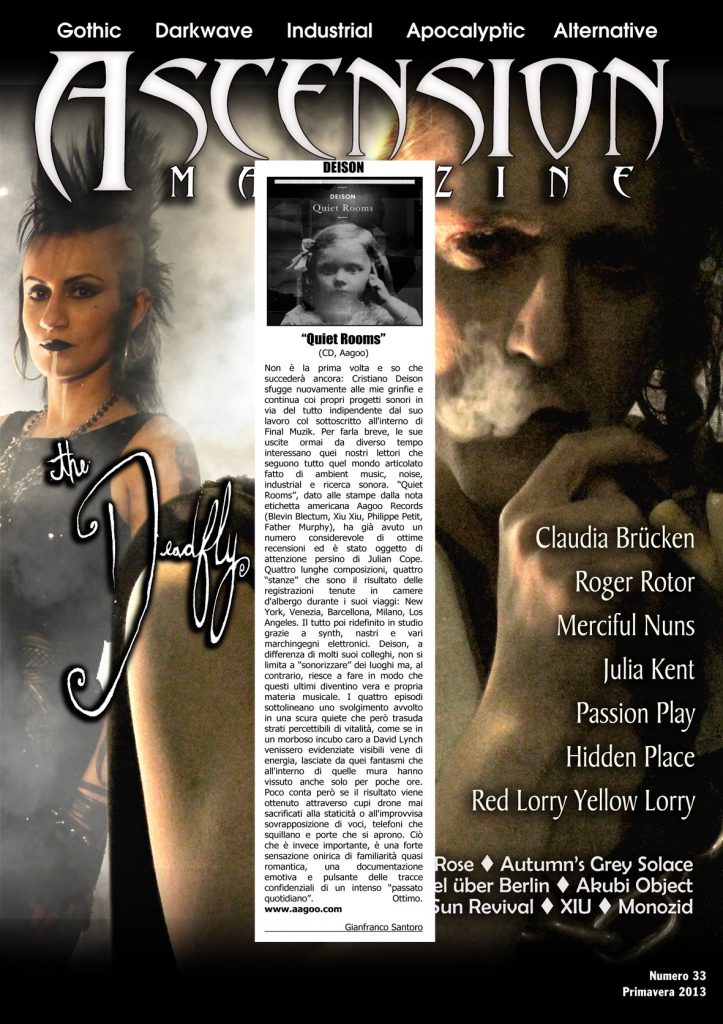
QUITE ROOMS ON NEURAL
The imaginative ambient sounds in this record were captured in four different rooms by Friulan sound-artist Cristiano Deison, a very ethereal manipulator not new to the international scenes, thanks to his work with artists such as Thurston Moore, Scanner and KK Null. In Quiet Rooms very dilated tonal drones dominate, feeding a dream climax that is rarefied and insinuating, sensitive and transient, and centered on the interaction between the strings and less abstract insertions (amplified draughts, hisses, door noises, a phone ringing, mewing cats). The breaks seem to underline the lifeless yearning of the stories that every place crossed by human vicissitudes somehow reflects. But perhaps this works only superficially; the idea that environments may “record” stories unavoidably affects the way we think and are influenced by those spaces. In this kind of procedure a persistent awareness inevitably arrives, making immediately visible shades of everyday life that in other contexts are barely recognizable. This creates a kind of aestheticism of daily life, with noises and sound fragmentations (excerpts of normal life) that are analogous to more incorporeal and stylized formal structures. As the title of the first of the four compositions suggests, the author undertakes a “Private Exploration”, executed in an ecstatic, dark and on the whole restless score.
QUITE ROOMS ON IGLOO MAG.
Very creepy rooms, filled with bad memories and stale air. There’s dust on the lampshades, damp under the wallpaper and bugs in the damp under the wallpaper. Italian sound artist Deison has recorded four pieces in empty hotel rooms from Venice to Los Angeles, four set pieces which share common ground with suspense movies in which rooms themselves are co-stars.
Older, run-down hotel rooms, not acoustically-adjusted, modern franchise chains, suggesting poor guests and guests with something to hide or to hide from, some shame, some crime. Art thrives on a certain amount of ambiguity, and that’s what Quiet Rooms contains—a certain amount. Its simple conceit is a beautifully chilling droning leitmotif, occasionally betrayed by a too few many sound effects—clacking train tracks, mobile phones, a cat meowing. However, the dust-mote drone that follows Deison like a blue malaise from room to room and across continents develops with excruciating patience over all four tracks till it gathers into a small vortex, collapsing all four rooms into one.
QUIET ROOMS: BEST ALBUM COVER OF THE YEAR ON A CLOSER LISTEN.COM
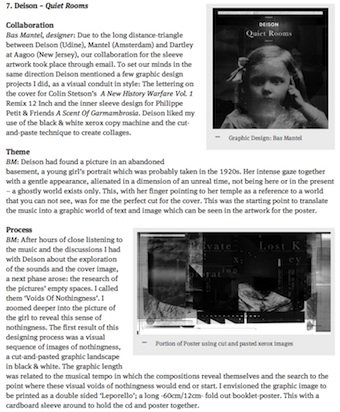
QUIET ROOMS: #8 TRA I TOP 12 ALBUMS PER INDUSTRIAL [r] EVOLUTION
QUIET ROOMS: #7 BEST ALBUM OF THE YEAR ON FLUID RADIO (UK)
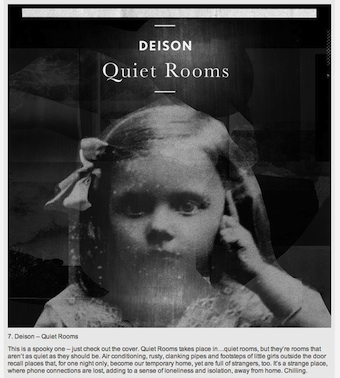
QUIET ROOMS SU THE NEW NOISE
Cristiano Deison vuol dire Meathead (con un certo Teho Teardo), vecchie fanzine e un programma radio, Cinise, Final Muzik e una carriera solista stracolma di collaborazioni (da KK Null a Scanner, da Lasse Marhaug a Thurston Moore), senza dimenticare il recente progetto Anatomy con Testing Vault. Quiet Rooms esce per Aagoo, che deve averci preso gusto con gli italiani (vedi Father Murphy… e io un po’ annetterei Philippe Petit…), con una delle copertine più disturbanti degli ultimi tempi (non voglio sapere se a quella bambina è successo qualcosa di brutto e non voglio capire perché la posa e l’espressione sono quelle di una persona con trent’anni di più).
Collaborare per Deison significa soprattutto arricchire uno stile parecchio essenziale. Senza ospiti di riguardo intorno, Cristiano torna a una sorta di purezza drone, per un disco buio ma non dark ambient. Sarebbe troppo facile, infatti, accostarlo a certe uscite di genere, ma in realtà è più vicino alla musica di ricerca e sostanzialmente distante da vari cliché gothic e industrial, per quanto sia come artista sia come ascoltatore lui mastichi tonnellate di quella roba. Quiet Rooms è un’avventura insonne in giro per un albergo non necessariamente infestato da spiriti maligni o gemelle morte ammazzate dal padre. Quello che si vive è uno stato liminale che non è veglia e non è sogno, una condizione di non perfetta lucidità, che però non ci rende troppo vulnerabili. Tutto suona ovattato e straniante, non spaventoso. Qualcosa ci dice che non dobbiamo stare tranquilli, ma è una sensazione sepolta nell’inconscio, non la percezione di un pericolo incombente. Magari lavoriamo semplicemente di notte (Night Sessions è il titolo del disco di Deison uscito nel 2011 per Silentes), siamo solo a pezzi e sappiamo che la realtà non ci apparirà mai come se fosse giorno: questa è la sensazione di “alterità” che l’album sembra trasmettere, tra il suono dei tasti di un telefono, il gracchiare di un ricevitore e altri rimandi al quotidiano presenti in forma di “field recordings”.
Per come i suoni sono puliti, in un certo senso Quiet Rooms non è poi così distante da certe cose 12k e dall’ultimo Lawrence English, delle quali sembra una versione più tinta di nero. Anche chi si è trovato bene con certo “isolazionismo” riportato in auge dalla nostra Glacial Movements non dovrebbe disdegnare le rarefazioni più scure di Cristiano. Bel colpo, ma astenersi ascoltatori impazienti.
QUIET ROOMS SU FREAK OUT
Approcciarsi a questo lavoro è difficile, tuttavia, una volta superata la prima difficoltà, ci si può perdere nei meandri di queste sonorità proposte dal progetto friulano capitanato da Cristiano.
La musica di Deison è un’elettronica avant-noise, tesa, spettrale e minimale.
“Quiet rooms” è diviso in quattro parti, o meglio in four rooms.
Si tratta, infatti, di un lavoro concettuale immaginato all’intermo di quattro stanze di albergo. A prescindere dalle intenzioni dell’artista quello che suscita è una forte angoscia distopica, introspettiva e post tragedia mondiale, lo stesso del film “The road”, che alla lunga può risultare catartico perché va a toccare i meandri più profondi dell’inconscio.
Insomma con questo disco si fa un bel viaggio dentro sé stessi.
Ma attenzione che durante il viaggio si può entrare che le parti che fanno più male della propria personalità.
QUIET ROOMS ON LIABILITY
Pour l’adepte du field recordings, voyager est quelque chose de quasiment essentiel. Cela lui permet de visiter des lieux dont on n’aurait pas idée, de collecter des sonorités qui nous paraissent inimaginables dans notre propre environnement. Cela ouvre aussi des champs d’expérimentations assez large. Celui opéré par Deison est du cadre de la comparaison. En effet, les pérégrinations de Cristiano Deison l’oblige la plupart du temps à séjourner dans des hôtels. Il s’est alors mis en tête d’enregistrer les sons qui traversaient les chambres dans lesquels il dormait. Ainsi, de Barcelone à Venise en passant par New York, Los Angeles ou Milan, Deison redonne vie à des spectres sonores qui, habituellement, ne sont que des bruits informes dont on ne finit par ne plus faire attention. Quiet Rooms est donc la comparaison, voire la combinaison puisqu’il n’y a que quatre compositions, composant une musique ambiant et environnementale qui est tout à fait saisissante. Pour autant, bien que Deison met en évidence ici des pièces de très bonne valeur, nous ne sommes pas spécialement étonné par la performance. Formellement, Quiet Rooms réponds aux critères du genre, sans en rajouter plus qu’il n’en faut. Deison ne serait-il qu’un créateur académique ? En tout cas, il ne donne pas ici l’impression d’être dans une dynamique de surpassement du dogme. Ce n’est pas un reproche parce que Quiet Rooms, dans le fonds, est d’une beauté incontestable et qui nous apporte une ouverture sur un monde qui rend audible ce qui ne l’était pas ou qui n’était considéré que comme fonctionnel. Deison donne de la poésie au réel mais il n’est pas le seul dans ce cas et Quiet Rooms, malgré toutes ses qualités cognitives, n’en est pas moins une œuvre qui respire un certain académisme. Ce n’est pas un défaut si la musique apporte les bonnes vibrations. Et Quiet Rooms est suffisamment armé pour cela.
QUIET ROOMS ON ROCKAROLLA
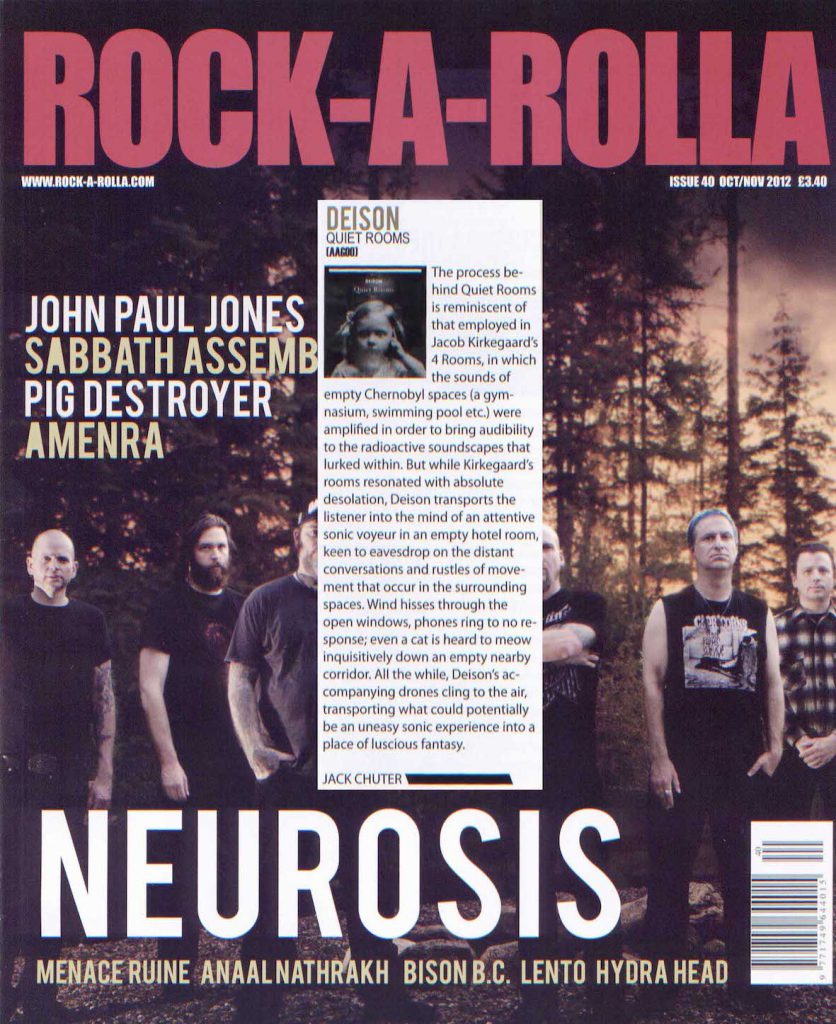
QUIET ROOMS ON THE GAP.AT
Zum dronig-ambientösen Klangfluss umgemodelte Aufnahmen leerer Hotelzimmer. Konzeptkunst wieder mal. Trotzdem schön.
Experimentelle Electronica kann eine ziemlich harte Nuss sein weil man auf diesem Feld – wenn man es geschickt anstellt – wirklich so gut wie jeden Unsinn legitimieren kann, ohne dass einem einer ankann. Ein mehr oder weniger ausgeklügeltes Konzept das die sonischen Ereignisse, ihre Entstehung oder ihren Hintergrund erklärt und passend dazu ein blumig formuliertes, kryptisches (De-)Kodierungssystem anbietet, ist da in der Regel die “Verkaufstaktik” der Wahl.
Im vorliegenden Fall hat der Italiener Deison leere Hotelzimmer in Barcelona, Venedig, Los Angeles, New York und Milan aufgenommen und aus den Aufnahmen vier dronige Ambient-tracks gebastelt … wird einem zumindest als Info dazugeliefert und kann daher bei derart abstraktem Material auch nicht ausgeblendet werden. Dass dann zwischen all den extrem langsam dahinfließenden – und sich dabei aber auch fortwährend mal mehr mal weniger subtil verändernden – Flächen und dem darunter liegenden Bassblock, auch relativ konkrete Sounds wie Waschbecken, Telefone, Züge oder Katzen im Hintergrund herumwuseln, scheint ein bisschen inkonsequent. Aber Schwamm drüber. Die vier zwischen zehn und 17 Minuten langen Tracks bieten Atmosphäre und Stimmungen, keine großartige Dramaturgie.
Isolation, Düsternis und dann aber auch wohliges Eingepackt-sein in weiche, heimelige Klangpolster. Noise oder grelle Brüche gibt es keine, auch die beunruhigenderen Teile bleiben zurückhaltend. Dass jemand mit technischen Hilfsmitteln aus Aufnahmen von Räumen, in denen sich ja viele kleine, fast unhörbare Prozesse abspielen, Informationen herauskitzelt, die den Ohren normalerweise verborgen bleiben, hat schon etwas Mystisches. Und dieses Forschen und Dinge Erschaffen und Herausarbeiten, die enweder vorher so nicht da oder nicht wahrnehmbar waren, ist ja auch das, was man sich von experimentell arbeitenden Künstlern durchaus erhoffen darf. Standardmethoden und -Sounds nach dem Zufallsprinzip zu variieren tun ohnehin schon zu viele.
Dass dieses Album es seinen Hörern durch “Wohlklang” relativ leicht macht, könnte man ihm schon fast wieder vorwerfen. Die Nähe zu Ambient ohne arty farty-Background ist gegeben. Unabhängig von der dahinterstehenden Intention ist das Album übrigens perfekt geeignet für lange nächtliche Autofahrten über vernebelte Landstrassen. Vom Rezensenten getestet. (5/10)
QUIET ROOMS ON KULTURTERRORISMUS
Hotelzimmer strahlen leer oder besetzt einen ganz eigenen Charme aus, den der langjährig aktive Interpret DEISON auf seinem aktuellen Album “Quiet Rooms” in Form von 4 Teilen in Tonkunst transformiert, die auf Feldaufnahmen beruht, welche der Italiener in unbesetzten Hotelzimmern in Barcelona, Venedig, New York, Los Angeles & Mailand aufzeichnete und anschließend zu Drones ausbaute.
Auch DEISON zählt nicht zu den labeltreuen Künstlern, obwohl er die italienischen Verlage Final Muzik & Loud! mit ins Leben rief, wo “Quiet Rooms” (CD + 16seitiges Poster) nicht erschien, der seine “leisen Hotelzimmer” über die in New Jersey, USA ansässige Tonträgermanufaktur AAGOO RECORDSpublizierte, deren Repertoire auch Größen wie PHILIPPE PETIT, PAS, FATHER MURPHY, ZULUS, COLIN STETSON usw. umfasst.
Hotelzimmer sind wahre Geschichtsbücher, aber ihre Verschwiegenheit zeichnet sie aus, weshalb ihre weltweite Reputation nie erlosch und Menschen aller Facetten ihre Dienste in Anspruch nehmen. DEISON’s “Quiet Rooms” gewährt nur einen winzigen Einblick hinter die “Kulissen” und offenbart im Endeffekt nur Nebenkriegsschauplätze wie vorbeifahrende Züge, Telefongeräusche, Türen ins Schloss fallen usw., heißt der Italiener kratzt nur die Oberfläche der Thematik an, die garantiert mehr Tiefe zulässt, aber totale Diskretion bestimmt das Geschehen. PS: Wer Enthüllungen will, muss die Klatschblättchen wälzen, hingen Freunde des Anspruchs erleben in “Quiet Rooms” von DEISON ein Paradebeispiel, das den Kern (Hotelzimmer an sich) eindrucksvoll beleuchtet, aber nie deren zeitlich begrenzte Besitzer in den Vordergrund rückt.
Sämtliche Ausgangstonspuren von “Quiet Rooms” basieren auf Feldaufnahmen, welche DEISON(?) in leeren Hotelzimmern aufzeichnete und mittels technischer Spielereien zu einem Soundtrack verflocht, der von Anfang bis Ende einnimmt. Teilweise erzeugte der Italiener eine derartige Intensität, dass die Atmosphären fast erdrücken, die er mit vereinzelten unveränderten Tonsamples akzentuierte, wodurch sich ein kurzweiliger Soundtrack mit hohem Wiedererkennungswert, dessen Strukturen auch nach dem x-ten Durchlauf noch vollends packen – Wahnsinn! Insgesamt ein sehr stimmiges Endergebnis, das DEISON mit “Quiet Rooms” erschuf, womit der Südländern garantiert zu den Aushängeschildern in Sachen “drehende Tonschleifen” (Drones) gehört!
Fazit:
Bei langjährigen Aktivisten wie DEISON liegt die Erwartungshaltung sehr hoch, welche der Italiener eindrucksvoll mit “Quiet Rooms” bestätigt – meine absolute Empfehlung! Individuen, die nach hoher Intensität/ Dichte verlangen, kommen bei DEISON’s “Quiet Rooms” voll auf ihre Kosten, das zudem durch seine Detailverliebtheit auffällt! PS: In meinen Ohren eine der Pflichtkäufe in 2012!
QUIET ROOMS SU SOUNDS BEHIND THE CORNER
In molti penseranno, dato che sono io a recensire l’opera di Deison, che sarò di manica larga data la mia conoscenza personale dell’artista, fortunatamente …Se siete tra quelli, sappiate solo che lo seguo da quand’era nei Meathead, e prima che un amico, per un decennio buono ed anche di più è stato per me influenza ammirevole ed artista, e tale rimane prima di tutto quando si giunge alla musica, perché il rispetto che nutro per la sua opera è definito tanto quanto il rispetto verso la sua persona, e favoritismi et similia, sarebbero una cosa decisamente non da me.
Quindi, sia chiaro che recensisco quest’opera esattamente come se fosse quella di un’artista che ascolto dai miei tredici anni, e che ho la possibilità di recensire – cosa che effettivamente é.
Disco dal packaging robusto di fattura (un plauso alla label per questo!), graficamente, come sempre, per gli standard grafici di Deison ed i lavori che presenta: straordinario ed inquietante, “Quiet Rooms” ci presenta Deison, dopo varie collaborazioni di prestigio con la ‘crema’ del rumore nostrano (vedi lo split tape con Atrax Morgue) e non (KK Null e molti altri), in una nuova veste. Per lui oggi la via del field recording, della drone music, delle suite… d’albergo, e di musica concreta: manipolate ad arte, come le luci in un set di David Lynch in una delle sue scene di calma apparente.
E ‘calma apparente’ è ciò che questo disco rappresenta senza ombra di dubbio: fonti registrate attorno al mondo, da una stanza anonima all’altra, dove i muri, finalmente, al contrario del famoso detto, sembrano finalmente parlare, e ci raccontano con rumori e suggestioni paranormali, quello che hanno visto, quello che hanno sentito …i silenzi solitamente possono trasmetter suspance, desiderio, tensione, ma orchestrati in questa maniera, i silenzi sono apparenti, mentalmente colpiscono con un rompighiaccio cospargendo il pavimento di desolazione, intimismo, di luci che illuminano teatralmente picchi emotivi di cui siamo testimoni …Di che tipo di emotività stiamo parlando, è difficile da identificare … provate a calarvi nel concept dell’album, cosa assolutamente non difficile, e troverete una sgradevole sensazione ad attendervi… i capelli freddi in fondo al lavandino, le lampadine che esplodono, una mosca che sta morendo nel vostro drink, sussurri accanto a voi, separati da un muro.
Un disco su cui ritornerete, stregati ed incuriositi, per saperne di più. (dANi/Alvo)
QUIET ROOMS SU SODAPOP
A questo giro ritorna Cristiano Deison, che vanta una carriera solista di tutto rispetto divisa fra dischi in proprio e collaborazioni o split con gente come KK Null, Scanner, Thurston Moore e Teho Teardo (assieme al quale aveva militato nei Meathead). Il friulano ritorna con un lavoro molto diverso dalla collaborazione con KK Null (giova ricordare che il disco con il giapponese è un capolavoro), infatti Quiet Rooms lo riporta su di un terreno in cui lo riconosco maggiormente. Ciò non tanto perchè sia più a suo agio alle prese con i drones, ma solo e semplicemente perchè nonostante qualche piccola variazione questo CD non è troppo distante dallo stile di altri dischi solisti di Deison (ad esempio il suo penultimo lavoro Night Sessions su Silentes). Drones soft e notturni che si stendono a tappeto e che in Quiet Rooms la fanno da padrone per tutta la durata del disco: nelle stanze attraversate dal friulano i “tappeti” vengono forati da alcuni suoni che arricchiscono il tessuto senza stravolgerlo, l’effetto è ben lungi dalla musica dark ambient e a tratti risulta persino estatico. Com’è lecito aspettarsi da un disco del genere i suoni vengono sviluppati lentamente, senza aver fretta di farli scomparire o di cambiare atmosfera, anzi Deison cerca di portarli più a lungo che può.
QUIET ROOMS ON SIDE-LINE
Cristiano Deison is an Italian musician who’s already been active for several years now. The most noticeable facts of his career remains the involvement in Meathead and being the co-founder of the experimental label Final Muzik. Experimental music for sure is one of the main sources of influences of Deison, but this new album brings much more.
“Quiet Rooms” is a strange conceptual release about ambient soundscapes from field recordings of empty hotel rooms. The idea of anxiety from isolation is a main theme that has been put into music on “Room 1”. There’s a kind of prosperity emerging of the track, but at the same time it doesn’t totally stand for loneliness. “Quiet Rooms” remains pretty quiet and reflects this comfortable feeling of serenity. The music takes us away into an imaginary deep, blue abyss. “Room 2” is a beautiful and well-crafted piece in the genre featuring a sublime progression.
Deison used field recordings, which are noticeable on “Room 3”. It here concerns ambient hotel noises. It might sound a bit weird and surreal, but it matches with the experimental work of this musician. The 4th track (cf. “Room 4”), which is also the last track of the album is a bit more animated through some kind of crashing sounds. It remains however, a very gentle and quite relaxing piece of music, which fully stands for the global style of the CD.
“Quiet Rooms” is a sort of experimental soundscape. I sometimes expected a kind of sound outburst, but the atmosphere always remains serene, controlled and pleasant.
(ED:6/7)
QUIET ROOMS SU EXTRA! MUSIC MAG
Semplicemente ipnotico ed emozionale. “Quiet Rooms” è un progetto di Cristiano Deison, un ragazzo friulano presente sulla scena ambient e della drone music già da diversi anni. Per chi non conosce la drone music, possiamo dire brevemente che è uno stile musicale minimal, che ricrea effetti armonici nei quali una nota o un accordo sono suonati in modo continuo per buona parte o per l’intera composizione.
Il risultato è veramente qualcosa di ipnotico. Deison infatti ha catturato e in seguito ricreato tramite la tecnica del “Field recordings” ovvero della manipolazione elettronica di registrazioni ambientali, i rumori presenti in stanze d’albergo sparse per il mondo: Venezia, Barcellona, New York, Los Angeles e Milano. Nella prima stanza – in tutto sono quattro – chiamata Private Exploration, l’artista cattura l’ansia dell’isolamento. Dieci minuti di pura sperimentazione. Sibili, fruscii e rumori sordi; oltre a sentirsi isolati dal mondo esterno ci si sente anche alienati.
Questo album ci regala un viaggio all’insegna della sperimentazione di suoni, che porta la nostra mente a creare storie fantastiche al limite del paranormale, tipiche di un film dell’orrore. E più si va avanti con l’ascolto, più la tensione cresce. Soprattutto nella terza stanza, ovvero Not Available; telefoni che squillano, porte che si aprono e si chiudono e un gatto in lontananza che miagola. La percezione è proprio quella di essere bloccati tra le mura di una triste stanza d’albergo, alle prese con i nostri pensieri più intimi e con la fantasia che, a questo punto, ha preso il sopravvento.
Siamo sicuri di riuscire a prenotare con serenità la prossima stanza d’albergo?
QUIET ROOMS ON A CLOSER LISTEN
Spectres circle Quiet Rooms, never appearing fully to the eye. Deep in the subconscious, we may be aware that something isn’t quite right, but any experience of paranormal phenomena is one out of sight, influenced by a slight, fearful dread and an urgency to avoid the unrelenting, breathless atmosphere cycling around the tiny bathroom. It may be due to a lack of ventilation, but it may be something else. The air is definitely colder in there, and in each of these four hotel rooms that become a temporary accommodation during our stay. Check in and enter…
A surreal sixth sense seems to be finely tuned for Italian experimental sound artist Deison. The recordings in Quiet Rooms are of empty hotel rooms that may not be as empty as we first thought. As the key clicks on the turn, the first striking thought is just how active in sound the rooms really are, even with no presence inside. Hissing pipes and ringing telephones erase standard musical elements; disappearing quarter and eighth notes are replaced by unique bars of music.
This is a spooky confine, void of personality and designed for transience, with no reassuring trace of home. It is this distance from home, in an unfamiliar place, that heightens the music’s increasing sense of isolation. These quiet rooms aren’t entirely soothing either, revealing just why there was a vacancy available. As Quiet Rooms advances, the peeling walls carefully kiss their secrets goodbye. Couple this with possibly the creepiest cover art in the world and we are left with a disturbingly eerie and yet sickly serene listen.
The ultra sensitivity in the unseen comes alive, both inside the ethereal air of drone and inside our very room. Dread, mystery and deep alienation absorbs into the walls, where a couple of paintings tilt at ever-so-slight, slanted angles; enough of an angle to seduce returning eyes again and again to that eerie painting. A ruffled curtain inhaling a thin breeze, a flitting obstruction filtering out the light under our doorway; these rooms have a dark history.
Shhhh.
Barcelona, Venice, New York, Los Angeles and Milan; all of these recorded cities become phantoms inside the music. Beautifully spectral, the music breathes the faintest touch of supernatural drone. Perhaps the most frightening thought comes in the knowledge that these recordings have been taken in real places and real environments; there is no artificial fiction to save us. Quiet Rooms could favour the haunted Overlook Hotel in The Shining – those weren’t pipes rattling in Room 217′s bathroom. The door remained locked for a reason, hindering any “Private Exploration”. “Lost Key” increases our separation from the world, and of loved ones distances apart. A rattling subway passes through the drone, and a cheap, electronic buzz allows us to creak open the door, a one night stand dressed in tacky curtains and a view of a pitch black alley. There’s no room service here.
‘The number you have dialled cannot be reached at the moment. Please try again later’.
All of the field recordings enter at will, much like any spirits who appear as they wish. Even the pipes sound different – colder than the ones at home – and the water tastes sour for some reason. Sleep is only a wishful dream. The reality is cold isolation and spiraling paranoia. Is that really just the air conditioning? It must be imagined, in the same way that The Shining was only a work of fiction and not an actual, physical hotel…if that’s what we are led to believe. “Not Available” turns to “Air Conditioning” in a seamless, perfect trance, drfiting in and out of sleep on pillows that feel like rubber.
Quiet Rooms is an eerie treat that deserves to be experienced; the trick is behind the fish-eye lens of room 217. Always a flux of activity, be it the paranormal kind or not, these hotel rooms are constantly occupied. New experiences absorb into the walls every day. The kids will certainly be scared if Quiet Rooms is your chosen ambience this Halloween. It may all be in the mind, but there’s still a feeling these rooms hold guests who never checked out. The lingering smell of perfume at 3. a.m; the little girl who was supposed to be a myth, now revealed around the sharp corner on the third floor.
Don’t forget to lock your door during your stay.
QUIET ROOMS ON BENZINE MAGAZINE
Avec Deison, figure de l’avant-garde musicale italienne depuis 20 ans, nous sommes plus dans une installation sonore, un concept, que dans un vrai album de musique, en tout cas comme on l’entend généralement. Comme son nom l’indique, Quiet Rooms a été enregistré dans des chambres d’hôtel de Barcelone, Venise, Los Angeles, New York et Milan. Le groupe italien a décidé d’en capter l’atmosphère de vide souvent angoissante. Une internalisation de l’espace (quelle différence que vous soyez aux USA, en Italie ou en Espagne ?) où Deison rajoute aux sons concrets (bruit de pas, d’eau qui coulent, de portes qui s’ouvrent…) des paysages électroniques ambiant accentuant l’impression initiale et poussant la réalité dans une nouvelle dimension plus fantastique. Le groupe apporte sa vision artistique à partir du réel. Ici par exemple, le souffle de l’air conditionné se transforme en une longue nappe musicale. En 4 longs instrumentaux, on ressent le même vertige que dans un film de Lynch où les choses les plus anodines deviennent mystérieuses. Album forcément fait pour être confidentiel, Quiet Rooms trouverait plus sa place dans une exposition d’art contemporain. Même si avoir le son sans l’image a de quoi interpeller et titiller l’imagination. (3.0) Denis Zorgniotti
QUIET ROOMS ON NONPOP
Young Italian DEISON’s been around 20 years in the business of sound experiments worked. Speaks well for him that he at this time not numerous publications, as has often noise or dark ambient genre usual, thrown on the market, but a clear number of albums and selected collaborations with NONPOP artists like ANNEN MOUNTAIN, TEHO Teardo or SCANNER presents.
His latest work “Quiet Rooms” treated as the name suggests, the atmosphere of empty hotel rooms. To the tapes and field recordings fetishist has gathered in major cities such as Milan, Los Angeles and Barcelona Images – ie sounds that were heard in those empty rooms – they reproduced, overlaid, processed on all sorts of forms and with subtle electronic drones provided. Result is four long tracks (between ten and 17 minutes) with slightly different orientations.
In the first of four rooms (“Private Exploration”, 01) hanging high, mysterious, spatial drones in the air, lined with barely perceptible, other room noise in the background. Everything goes through soon in a joint rumble that makes a very alien-like impression. A living, breathing room, with its walls in the distance and noise of phones or keys can be heard. After a few minutes the room is warmer, the clear drones shimmer and float quietly, give peace and security. Again and again, from field recordings on this mood, as on the album away.
The transition to “Lost Key” (02), the second space is seamless. The atmosphere here is something verwehter, spherical. Drones are like a cosmic, slow motion-like chimes in the air, either a feather played giant organ is considered. Sounds like the opening and closing of doors bring into radio play character.
Also, “Not Available” (03) consists mainly of elongated, spherical drones with some also prolonged field recordings. In the last and longest piece, “Air Conditioning” (04), the mood changes again: Friendly and bright, several clear drones together, sacred in their appearance. They act in between such as overtone singing, the only changes in shades and shiny weighs in the air.
Once again, amazing what is possible with minimal means, like for minutes only by slight changes emotions and associations are created. Solitude, silence, solitude, loneliness and many other emotions that are associated with the idea of a hotel room in a foreign country gives, DEISON very descriptive and sometimes very comforting. Do not disturb!
QUIET ROOMS SU STRATEGIE OBLIQUE
Deison mantiene nei contenuti di “Quiet Rooms” le aspettative racchiuse nel significato del titolo. Si tratta infatti di quattro movimenti (denominati “Room I-IV”) che riflettono le sensazioni e gli scenari immaginari di stanze silenziose, con le loro ansie, i loro rumori ambientali e un drone di sottofondo che accompagna l’intera registrazione. Circa quarantasei minuti di muisca ambient, intesa come proiezione in sound del nulla. Il niente che anziché essere fatto di spazi vuoti viene riempito con una sorta di densità sonora che oscilla tra momenti più o meno intensi. Una musica che sembra non avere mai inizio, ma che a conti fatti si rivela infinita, da mettere in loop fino a formare un’onda continua che inesorabilmente invade l’area circostante. Proposta che al semplice ascolto non risulta di grande appeal, e che porge il fianco alla facile distrazione, ma che potrebbe rivelarsi decisiva in caso di installzione artistica, a commento di immagini che ne amplifichino gli eventuali significati. Chiamala se voui avanguardia.
QUIET ROOMS SU SHIVER WEBZINE
Una immagine di copertina scura e leggermente sfocata, costituita da diverse immagini che si sovrappongono-confondono, sovrastate dal ritratto di una bambina nel quale sguardo ci si perde in una sorta di introspezione ipnotica: una cartolina dall’aldilà verrebbe da pensare! Il musicista d’avanguardia di origini friulane Cristiano Deison – sperimentatore audace da almeno vent’anni a questa parte – non avrebbe potuto scegliere un abito più azzeccato per presentare le sue quattro nuove composizioni edite per la Aagoo Records (etichetta che ha in catalogo quasi esclusivamente lavori di area sperimentale/avanguardistica) che rappresentano un disco concettuale assai interessante quanto ostico.
Il tema cardine di Quite Rooms è la rappresentazione – o per meglio dire evocazione – sonora di quattro stanze d’albergo, vuote (da qui il titolo del disco), che prendono forma attraverso il lavoro dronico di Deison che non è altro che manipolazione elettronica di registrazioni ambientali (la tecnica del “field recordings”) catturate in stanze di alberghi di Barcellona, Venezia, New York, Los Angeles e Milano. Utilizzando l’alfabeto della musica elettroacustica ed elettronica minimale – in senso lato – Deison ha anche deciso di definire musicalmente ognuna delle quattro stanze con un “umore” particolare (i titoli affidati ai movimenti forniscono taluni elementi di comprensione: “Private Exploration”; “Lost Key”; “Not Available”; “Air Conditioning”), manipolando le atmosfere base su coordinate che rimandano di volta in volta a sentimenti di angoscia, confusione, spaesamento e sorpresa.
Si ribadisce che si tratta di musica concettuale e quindi sarebbe bene ascoltare i quattro strumentali del disco tenendo ben presente il concetto di fondo del quale vi abbiamo parlato: solo in questo modo si possono apprezzare compiutamente le micro variazioni proposte da Deison, godendo appieno degli innumerevoli dettagli che solo ascolti ripetuti – meglio se in cuffia – possono far scoprire. Una cartolina dall’aldilà verrebbe da pensare! (anche ascoltando il disco).
QUIET ROOMS SU INDUSTRIAL (R)EVOLUTION
Ecco cosa deve aver provato Wendy mentre si aggirava sperduta per le stanze dell’Overlock Hotel durante l’autoreclusione a cui il marito Jack aveva costretto tutta la famiglia. Un immenso albergo pieno di stanze vuote, silenti e intrise di un misterioso misto di atmosfere. L’affascinante “Quiet Rooms” è qualcosa di simile, perchè Deison, da capace ed intelligente esploratore del suono qual è, ha deciso di scavare tra le crepe dei muri di un albergo vuoto, scoprendo emozioni incrostate tra l’intonaco degli anni. Paura, serenità, senso di straniamento, smarrimento, ricerca, questa è parte dell’ampio spettro evocato da Deison grazie a field recordings centrati e densi, frutto di un lavoro paziente e meticoloso. Ma “Quiet Rooms” è anche introspezione, riflessione, ascolto di sé e richiamo all’ascolto di una realtà spesso annacquata dal marasma quotidiano, invito a guardare dentro e ad andare oltre le apparenze della luce e del scintillio, per fermarsi a sentire cosa hanno da raccontare nude stanze vuote.
QUIET ROOMS SU INDIEYE ZINE
Il friulano Deison (all’anagrafe Cristiano Deison), artista presente sulle scene internazionali da almeno 20 anni (in curriculum ci sono split album insieme a Thurston Moore, Scanner, KK Null), ritorna per Aagoo Records con un nuovo lavoro, “Quiet Rooms”.
Il disco, ancora una volta caratterizzato da una forte indole sperimentale, si compone di quattro brani (da intendersi come quattro descrizioni sonore di ideali stanze d’albergo) costruiti prevalentemente su lunghi drones e registrazioni ambientali (telefoni che squillano, rumore di pioggia, rumore di automobili, ecc…). Il risultato è un lavoro decisamente dilatato e rilassante (nonostante la dinamica in crescendo dell’intero album) in cui, travolti dalla propria immaginazione, vale la pena perdersi. Un disco decisamente evocativo.
QUIET ROOMS SU ROCKERILLA#386
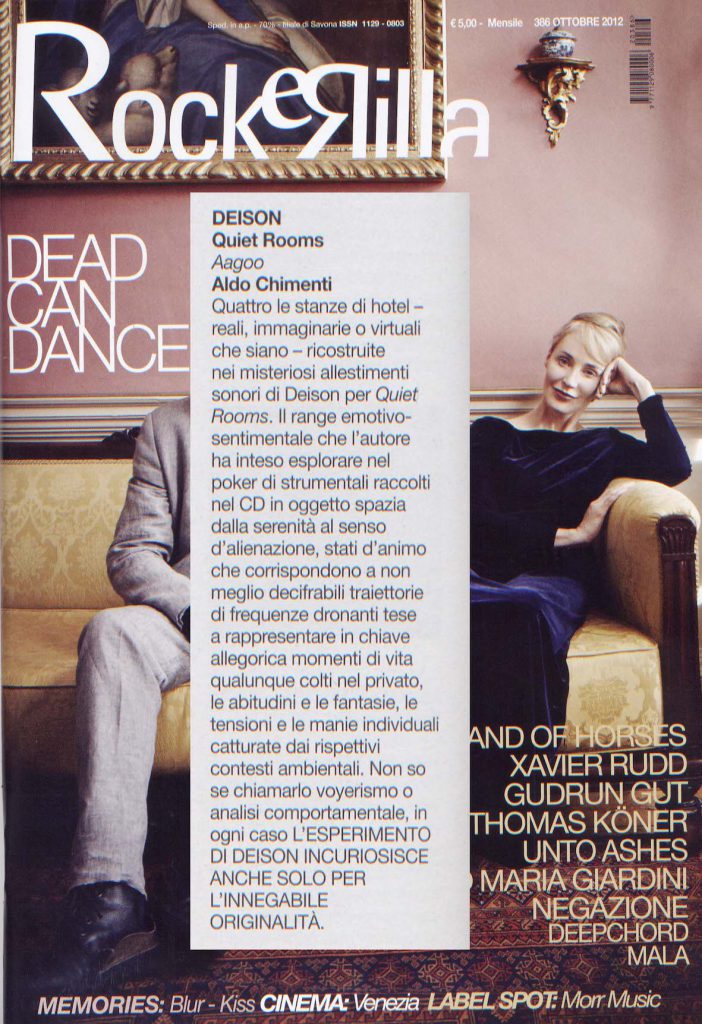
QUIET ROOMS SU MOVIMENTA
Nel film Hotel Room, prodotto per il canale televisivo HBO, ed andato in onda nel Gennaio del 1993, David Lynch ambienta tre storie nella stessa camera di albergo, la numero 603 del Railroad Hotel di New York, ma in periodi diversi: la prima storia, Tricks, si svolge nel 1969; la seconda, Getting Rid Of Robert, nel 1992; in Blackout, la terza ed ultima – e senza esagerazioni, una delle cose migliori mai girate dal regista americano – si torna indietro fino al 1936. lo stesso tema, distrutta ogni unità di tempo e di spazio (le stanze non hanno alcun corrispettivo reale) viene affrontato dall’album Quiet Rooms del musicista sperimentale Deison, che esce oggi per Aagoo Records: i brani sono tutti costruiti con un lavoro di manipolazione e composizione di registrazioni ambientali fatte in camere d’albergo di Barcellona, Milano, Venezia, Los Angeles e New York. che musica aspettarsi da un disco del genere non è difficile da immaginare – insomma, ad essere suonate sono, letteralmente, delle stanze vuote (che a loro volta, per mezzo di una copia dell’album, potranno suonare nella stanza dove si trova l’ascoltatore, ed insieme ad essa, per un definitivo mind blow): elementi che la memoria e l’esperienza di ognuno possono collegare ad un hotel (lo squillo di un telefono, un tintinnare di chiavi) ricorrono in un flusso sonoro più emotivo che narrativo, evocando atmosfere care proprio a Lynch, per ricollegarsi all’incipit di questo pezzo, o al poeta Tomas Transtromer, volendo vagare per più libere associazioni mentali. e proprio mentale, non sembri in contraddizione con l’aspetto emotivo di cui si è appena detto, è la drone music di questo album, capace di unire materialismo e metafisica. perchè, se il compito della fisolofia è quello di porre domande, la creazione artistica è sempre stata una valida suggeritrice di risposte.
QUIET ROOMS ON TEXTURA.ORG
With drone releases available in such plentiful number, the artist crafting one is well advised to devise some novel concept by which to distinguish his or her music from those of others. And to C. Deison’s credit, that’s exactly what the experimental artist has done in using field recordings of empty hotel rooms as the primary sound source for Quiet Rooms, forty-eight minutes of ethereal ambient-drone atmospheres. The material is best experienced as a headphones listen, naturally, given the textural detail that flows eerily throughout the recording’s four settings.
Deison, who’s been active in the noise and electronics underworld since 1991 and has appeared on split releases with figures such as Thurston Moore, Scanner, and KK Null, brings a patient and assured hand to the recording’s material in allowing it to unfold and develop in carefully composed manner. While certain passages are soothing, tension is nevertheless omnipresent, in large part because the absence of a human presence within the space leaves the listener wondering what explanation might be offered for the sounds featured. Of course, ambient hotel noises do repeatedly inhabit the empty spaces—doors open and close, a water tap dribbles, a cat meows, a subway train clatters, and an automated answering machine message fills the space—but slowly drifting tones inhabit the rooms as plentifully and as a result the ghostly character of the pieces is maximized. The longest setting at seventeen minutes, “Air Conditioning” brings the project to a climax with a towering ambient-drone that’s the densest of the four. In this case, the real-world details recede and the aural space is dominated by an immense, slow-moving mass of blur and shimmer that even, in isolated moments, assumes an aggressive industrial quality.
For the record, it should be mentioned that the recording is not an entirely pure document of empty room spaces, as Deison also drew upon electronics, synthesizer, and tapes in creating the four pieces in addition to hotel room sounds recorded in Barcelona, Venice, Milan, New York, and Los Angeles. Even so, one comes away from the recording hearing the so-called empty room with fresh ears as a living, breathing entity within which a ceaseless stream of activity, human or otherwise, arises.
QUIET ROOMS ON VITAL WEEKLY #847
A few weeks ago my 13 year old daughter wanted me to watch ‘1408’, a film about a haunted hotel room, which we did. It was alright. In return I made her watch ‘The Shining’, which she thought scarier, especially because of Jack Nicholson’s performance. Otherwise hotel room rarely give me pleasure: the beds are too short. Over the years (Christiano) Deison has taped various empty hotel rooms in Barcelona, Venice, New York, Los Angeles and Milan and these recordings have been used in the four pieces on this CD. An empty hotel room doesn’t mean a silent room. We hear lifts (or is that elevators), phones, doors, windows of other rooms and many obscured activities which one happens to hear in hotel rooms. Deison has created four tracks in which the backdrop is made of deep drones. These seem to go from track to track, and of course rooms in hotels are similar, but this is a bit too much. Also the quick fade in in ‘Room IV: Air Conditioning’ breaks that flow. It makes all four pieces a bit too much interchangeable I think, but if you look at each track individually then you notice an interesting scary movie soundtrack. Phones start out of nowhere, bangs and clatter in the next room, and all such like. There could be something there indeed. And all this time you are lying on your bed, carefully examining all of these sounds. If Deison wanted to deliver an open solicitation as a composer of soundtracks, then ‘Quiet Rooms’ is a successful one. As a whole album, I must say I am less convinced. It’s too single minded in it’s drone approach and ‘scary’ sounds. A bit more variation would have been nice or perhaps make one long piece and divide it into various scenes. (FdW)
